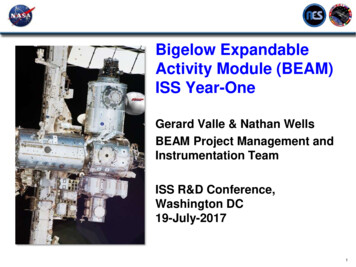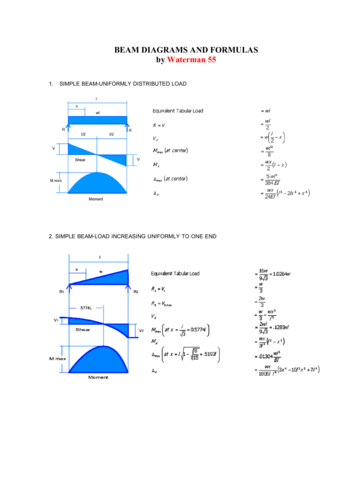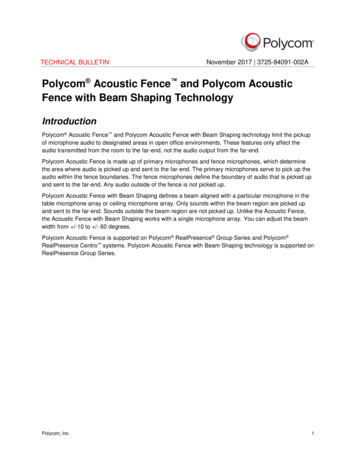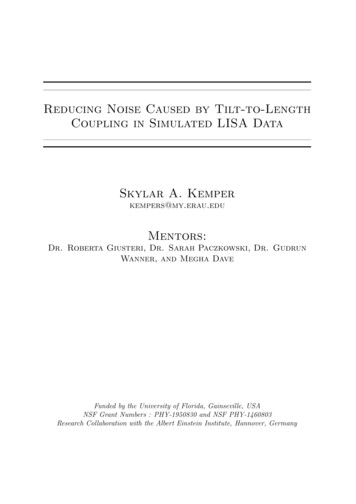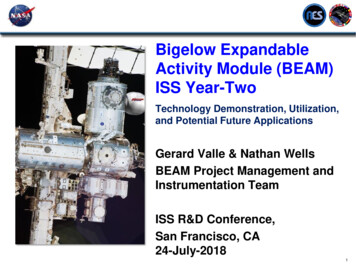
Transcription
Bigelow ExpandableActivity Module (BEAM)ISS Year-TwoTechnology Demonstration, Utilization,and Potential Future ApplicationsGerard Valle & Nathan WellsBEAM Project Management andInstrumentation TeamISS R&D Conference,San Francisco, CA24-July-20181
Agenda1. Project Overview2. Crew Ingress3. BEAM General Performance 4.5.6.7.BEAM ProjectMicrobial Air & Surface MonitoringDeployment DynamicsThermalMMOD Impact DetectionModal TestRadiationUtilization as a Stowage ModuleLife ExtensionFuture Plans & SummaryTeam Acknowledgements2
BEAM project objectivesBEAM on ISS Node 3 Aft Demonstrate a commercial expandable habitat module on ISS in partnership with BigelowAerospace (BA) Increase human-rated inflatable structure Technology Readiness Level (TRL) to 9 Address key elements of NASA’s Space Technology Roadmaps to prepare for future deepspace and surface habitat missions Exploit experience from NASA’s TransHab design and BA’s Genesis I & II pathfinder flightsBEAM animation by NASA/JSC on YouTubehttps://youtu.be/VopaBsuwikkBEAM Project3
BEAM expanded configurationNot shown: Rip-Stitch Straps (RSS)next to ADSS strutsBEAM IMV DuctAnomalous Depressurization andStabilization System (ADSS) struts (x4)Shear Panel (x8)PCBM to BulkheadTunnel AdapterAft BulkheadBEAM HatchForward BulkheadBEAM ProjectAir Tanks (x8)4
BEAM launched, berthed, anddeployed on ISS BEAM launched on SpX-8 (April 8, 2016), Dragon/BEAM arrived Node 2 (April10th), SSRMS extracted BEAM from Dragon Trunk on Node 2 Nadir, moved it to Node 3,and berthed it on Node 3 Aft port (April 15-16 2016), and fully pressurized on May 28, 2016.BEAM Project5
BEAM Ingress Timeline (through 2-years)OperationsDateIngressJune 6-8, 2016 Outfitting interior, installed sensors, and took microbial air/surface samples1-3Replaced DIDS battery packs -- DIDS back to nominal ops, reattached 5 accelerationsto shell with Kapton tape, retrieved exposed RAM's for return in Soyuz 46S5-Sep-164Performed Modal Test; IWIS data not recorded due to bad cable connection,29-Sep-16 preemptive Kapton-taping of 7 accelerometers524-Oct-16 RAM install and microbial sampling62nd Modal Test, RAM swab and microbial sampling1-Feb-17722-Mar-17 RAM swap, microbial sampling, accelerometer inspection828-Apr-17 1st REM shield installed (1.1 mm thick)931-May-17 2nd 3D-printed REM shields (3.3mm thick) installation & new RAMs1020-Jun-17 3rd (final) 3D-printed REM shield (10mm thich) installation11flipped 10 mm dome31-Jul-171222-Aug-17 microbial tion tanks, stowage box, cables, Ingress #721-Nov-17 installed hardwire sensors, PMA, duct extension, empty M-bags, microbal sampling1522-Feb-18 microbial sampling, reattach sensors, remove 10mm REM shield, LEE and CTB stowage1618-May-18 WTS 1003 battery replacement, microbial/air sampling17LEE removed, DIDS cable swap (extension), DIDS and WTS battery swapTBD18Add supplemental BEAM Stowage (up to 109 CTBE).TBD19 20Ingress #46
BEAM – Microbiological Monitoring BEAM ProjectAugust 22, 2017November 21, 2017February 22, 2018May 18, 20187
BEAM Sensor System OverviewSensorParameterDeploymentData Retrieval Previous UseDistributed ImpactDetection System(DIDS)Detects structuralimpacts to BEAMInstalled pre-launch: 4 transducers on thebulkheadsInstalled on orbit: 12 transducers on thesoft goods sensor boxesRF to SSC(closed hatch)ISS UltrasonicBackground NoiseTest SDTODeploymentDynamics Sensors(DDS)Records accelerationloads during inflationstage3 DDS units and triaxialaccelerometers areinstalled prelaunchUSB to SSC(BEAM ingress)Shuttle WingLeading Edgeaccelerometers andCrew Seat DTOWireless TemperatureSensors (WTS)Monitors temperatureof BEAM surface(IVA)4 WTS units Installedon-orbit (qty 4 RTDchannels each)RF to SSC(closed hatch)Shuttle WirelessStrain GaugeInstrumentationSystemRadiationEnvironment Monitor(REM)Monitors radiationenvironment internalto the BEAM structure2 REM Installed on-orbitUSB to SSC(closed hatch)REM SDTORadiation AreaMonitor (RAM)Passive radiationmonitoring badges6 RAMs Installed onorbitReplaced andreturned to groundevery Soyuz vehiclecycleBEAM Project8
BEAM Sensor System OverviewWTSDIDSREMBEAM ProjectRAMDDS9
Deployment Dynamic Sensor (DDS)Purpose: Used as a technology demonstration for characterizing the BEAM Module deploymentdynamics with accelerometers on the Aft bulkhead surface.Deployment: Hardware pre-installed prior to launch on Aft bulkhead.Qty 3DeploymentDynamicSensor (DDS)unitsQty 3 triaxialaccelerometersBEAM ProjectQty 8 AirInflationTanksQty 4single axisaccelswithcables forDIDS10
DDS Sensor Results for DeploymentMonitoring The DDS successfully recorded 10 hrs of accelerometer data during theBEAM deployment. Thousands of impulses were measured from the Rip-Stitch Strap (RSS)stitches popping. Max 0.5g peak during initial inflation attempt and max 0.3g during thefinal inflation. No indication of ADSS struts binding or high transient loads on ISS.Inflation Day 1( 2.5 hours)Inflation Day 2(final hour) DDS was also used to support Modal testing inside of BEAM.BEAM Project11
Wireless Temperature Sensor (WTS)Purpose: Used as a technology demonstration for characterizing the BEAM Moduleinternal temperature environment during the 2 yr operational phase.Deployment: Qty 4 Wireless Temp System Kits installed on-orbitOperations: Each WTS data recorder samples 4 Resistive Temperature Device (RTD)channels once per minute and stores to local memory. Data is downloaded wirelessly 1/month to a laptop in Node 3 and then downlinked to the ground.Qty 4 Resistive Temp DeviceSensorQty 1 Extended LifeBattery PackQty 1 Wireless TempSensorQty 1 Battery Pack CableWireless Temp Sys Kit Contents12
BEAM Thermal Performance A total of 16 WTS RTD sensors were installed with tape inside of BEAM. 12 sensors were placed radially along the BEAM inner air barrier and 2 sensors on the Forward and Aftbulkhead surfaced respectively. Approximate locations are shown below. Initial pre-expansion internal temperatures measured by the DDS system were significantly warmer thanpredicted analysis temperatures which was likely due to the folded soft goods layer creating an additionalthermal isolation not modeled. Current model of the Expanded Module tends to under predict the WTS readings. BEAM demonstrated adequate thermal control and condensation prevention with unobstructed and partiallyobstructed ventilation from the ISS IMV, nominally at 22.6 ºC and 3.4 m³/min, and ISS atmosphere humiditylevels (dew point) from 5.6 to 12.8 ºC (Relative Humidity 33 – 54%)Locations of the 16 WTS sensors (a) BEAM aft bulkhead, (b) air barrier and (c) forward bulkhead** Graphics and data on this slide and the next were provided by the BEAM NASA/JSC Passive Thermal PrincipleInvestigators John Iovine & William Walker13
Distributed Impact Detection System OverviewPurpose: Used as a technology demonstration for Micro Meteoroid/Orbital Debris (MM/OD) Impactdetection system of an inflatable structure for BEAM Module during the 2 yr operational phase.Deployment: Qty 4 Accel Transducer cables installed pre-launch to Aft Bulkhead and remaining kittedhardware installed on-orbitOperations: Each DIDS data recorder remains in a low power listening mode until a trigger is recordedabove a set g threshold value and records a 270 ms of 30 KHz sampled data window to internalmemory for each of its independent 4 channels. New trigger status is downlinked daily and raw triggercan be downlinked on an as needed basis.Qty 1 Battery Pack CableQty 1 Antenna MountQty 1 Accelerometer DataRecorderQty 4 Accel TransducerCableQty 1 Extended LifeBattery PackImpact Detection Kit Contents14
Distributed Impact Detection System Overview Detects MM/OD and IVA Events Uses 3 VDC custom designed external Battery Pack, expected operationallife of 2 years. Can store 9999 events on an internal memory card Verified that adhesive attachment method for accelerometers to smoothsurfaces (Bladder) survives HVI impacts. BEAM air barrier had been pre-marked forDIDS/WTS sensor installation locations. Sensor locations were configured to ensuremaximum internal coverage and to monitor preflight identified high risk MM/OD impact probabilitylocations. 12 DIDS piezoelectric accelerometerswere adhered to air barrier via pre-applieddouble-sided transfer tape and Kaptontape by crewNOTE: NOT Actual sensor location!DIDS Sensors locations are for illustration purpose only.DIDS Sensors are Internal toStructure.15
DIDS Sensor Labeling/On-Orbit InstallationB1W1B2W2BB4W4B3W3BEAM Mock-up ViewBEAM Sensor 3D Model ViewNote: Cables attached to inner air barrier with 13/8” dia Velcro dots16
BEAM Impact Detection Performance Overview Initial DIDS operations required engineering to tweak the trigger thresholdparameters to ensure DIDS accelerometers would not falsely trigger due tolow level ISS background noise being injected into the module structure. Crew activity induced loads to structure have been routinely recorded duringprevious crew ingresses in the module DIDS operations had to be adjusted initially to disable an internal amplifierwhich had been left active and was causing increased power consumption.17
BEAM Impact Detection Performance Overview On GMT 059 (2/28/17) first likely external impact to BEAM was recorded byall three DIDS units monitoring the internal air barrier surfaces. Recordedsignals ranged between 1 - 3 g’s acceleration Signal contained high frequency content Triangulated to have impacted on Zenithside (between Channel 2 & 3) Estimated impact amplitude on restraint layeris 260 g’s based on hypervelocity ground testderived models and data suggests the impact wouldnot have penetrated all the way to the restraint layerEstimated epicenter location of GMT059impact Pictures of estimated impact location were requested via the ISSExternal High Definition Camera (EHDC) P1LOOB, however the cameragave very little Zenith surface viewpoint18
BEAM Radiation Sensors A total of 6 Passive and 2 active radiation sensors were installed inside of BEAM viavelcro. The Radiation Environment Monitors (REMs) couples small radiation sensor withadvanced electronics Consist of a Timepix read-out chip bonded to a 300 µm thick, 2cm2 silicon sensor layer.The Timepix provides on-chip data collection and signal digitization within the footprint of each of the individual pixelsin the 256 by 256 pixel matrixPower/data provided via USB and connect to Space Station Computer laptop in Node 3Provides spectral information (energy deposition as function of particle type and energy) and radiation dose Radiation Area Monitors (RAMs) came back to ground during nominal ISS Soyuzreturn cycle for data evaluation. RAM sensor monitoring discontinued in Dec. 2017.Passive Instrumentation (RAM)Active Instrumentation (REM)19
Radiation Performance Radiation (REM) initial results System has been operating without issues since installation Galactic Cosmic Ray (GCR) dose rate similar to other ISS modules As expected, REMs measured higher trapped field dose rate — e.g., in SouthAtlantic Anomaly (SAA) — inside BEAM than in other ISS modules due tothinner shell and lack of equipment racks in BEAM technology demonstrator A test was performed to determine if the particles being measured inside ofBEAM are of low energy and if so, can they be effectively shielded out with 3Dprinted plastic hemispheres of various thicknesses (1.1mm, 3.3 mm & 10mm. Results were inconclusive. No noticeable change noticed. A better comparison will be made when BEAM is filled with stowage items. BEAM tech demo data will be used to assess shielding requirements forexpandable habitat modules configured for human exploration missions20
BEAM Stowage Module Utilization BEAM Contract Updated to support utilization as a stowage module and lifeextension BEAM completed 2-year certified life under original contract All milestones met and BEAM performed nominally BEAM de-outfitted to support utilization as a stowage module Removed tanks, stowage box, cables Converted wireless WTS and DIDS sensors to wired configuration Extend vent duct to meet air flow requirements Installed 420 pound failed Latching End Effector (LEE) plus 610 pounds ofcargo inside of BEAM21
BEAM Stowage Module Utilization BEAM with 109 CTBE Stowage22
BEAM Life Extension through End of ISS Life BEAM meets MMOD penetration requirements through 12/31/2028 BEAM meets stress requirements for a fully loaded (109 CTBE)configuration Fully loaded (109 CTBE) BEAM meets fatigue requirements through 2028 ADSS needs to be reinforced in order to meet stress and fatiguerequirements for a fully loaded BEAM in the off-nominal depressurized state Currently working on reinforcing ADSS utilizing on-orbit hardware(repurposed handrails)23
BEAM Future Plans & SummaryFuture Plans BEAM was originally planned for a 2 yr operational mission to demonstrateand advance the technology with infrequent human ingresses. Utilize BEAM as a stowage module Extend BEAM life to end-of-ISS-life Conduct additional experiments inside BEAMSummary Overall BEAM has been performing beyond expectations! BEAM has advanced human rated expandable modules to TRL 9 and in thefuture should be considered as a solution for volume/mass savings in futureplanetary and space exploration applications. Use BEAM sensor data and lessons learned to fold into future expandablemodule design24
Future Expandable Spacecraft Potential Uses Full-sized Inflatable Module on ISS Next Step-2 Inflatable Airlock Next Step-2 Gateway Deep Space Station Module Next Step-2 Gateway Inflatable Surface Module (Lunar or MARS) MARS Transits Module TransHab25
Team Acknowledgements The authors of this presentation would like to provide a special thanks to theentire BEAM project team and Bigelow Aerospace. Specifically the authors would like to acknowledge the following people whoprovided BEAM specific performance data: Microbial Monitoring Performance – Ariel Macatangay, William Misek & MelanieSmithDeployment Dynamics & Modal Test Results – Michael GrygierThermal Performance – John Iovine, Dr. William Walker, and Zaida HernandezMM/OD Monitoring Performance – Dr. Eric MadarasRadiation Sensor System & Performance – Dr. Dan Fry and the entire SpaceRadiation Analysis Group (SRAG)26
BackupBEAM Project27
Why Expandables? (1/2)1. Lower launch/ascent volume relative to metallic modules Pro: Reduced size, drag and mass of the launch vehicle (or fairing), or morecargo inside the same fairingCon: Increased complexity for deployment and internal outfittingBEAMMass (w/ PCBM & FSE)PackedInflated 1400 kg ( 3K lb)Inflated/PackedRatio1.0Volume3.6 m316 m34.4Length (w/ FRGF)2.16 m4.01 m1.9Diameter2.36 m3.23 m1.4Pressure014.7 psi-BEAM/Trunk integrationBEAM ProjectPacked BEAM on ISS N3Key benefit of inflatables:launch small, then get bigin space or on the surfaceof the moon or MarsDeployed BEAM28
Why Expandables? (2/2)2. Less mass for the same volume as metallic modules? Maybe. Depends upon mission and design requirements, outfitting, materials, size, etc.Current expandable module experience only at low volumes, not mass-optimizedSmall, mass-optimized metallic modules can be less dense than robust BEAM tech demoLarge expandable module designs potentially offer lower density due to much greaterspecific strength of fabrics vs. metal alloys, though this must be proven in flightMore experience with expandable modules may reduce mass due to reduced factor ofsafety (e.g., ISS requires FoS 4.0 for fabric structures, 2.0 for aluminum) Quick-Look Module Density Comparison300ExpandableDensity Mass/Volume (kg/m3)250MetallicOther ISS modules200150Genesis100BEAM50Kibo JEMSkylab Orbital WorkshopCygnus PCM (enhanced)Leonardo PMMBA330 designTransHab design0050100150200250300350400Volume (m3)BEAM Project29
BEAM internal WTS Temperature measurements30
BEAM internal WTS Temperature measurements31
32
BEAM Impact Detection Performance OverviewDIDS Unit 1119, 2/28/2017, 34DIDS Unit 1119, 2/28/2017, Event 343322DIDS Unit 1119, 2/28/2017, Event 342.0E-021Ch 1 (g)1.5E-020Ch 2 (g)Amplitude (g)0Amplitude (g)Amplitude (g)1-1-1-2-2-3-3Ch 1 (g)1.0E-02Ch 2 (g)Ch 3 (g)Ch 4 (g)05101520Time (msec)255.0E-030305101520Time (msec)2/28/2017 at 14 hrs: 11 mins: 7.189 secs25302/28/2017 at 14 hrs: 11 mins: 7.189 secs0.0E 000322110Ch 3 (g)11.522.533.542/28/2017 at 14 hrs: 11 mins: 7.189 secsZenith DIDS FrequencyResponse0Ch 4 (g)-1-1-2-2-30.5Freq. (KHz)DIDS Unit 1119, 2/23/2017, Event 343Amplitude (g)Amplitude (g)DIDS Unit 1119, 2/28/2017, Event 34-3051015Time (msec)2025302/28/2017 at 14 hrs: 11 mins: 7.189 secs051015Time (msec)2025302/28/2017 at 14 hrs: 11 mins: 7.189 secsZenith DIDS Time History (all 4 channels)33
BEAM Project BEAM launched, berthed, and deployed on ISS BEAM launched on SpX-8 (April 8, 2016), Dragon/BEAM arrived Node 2 (April 10th), SSRMS extracted BEAM from Dragon Trunk on Node 2 Nadir, moved it to Node 3, and berthed it on Node 3 Aft port (April 15-16 2016), and fully pressurized on May 28, 2016. 5
